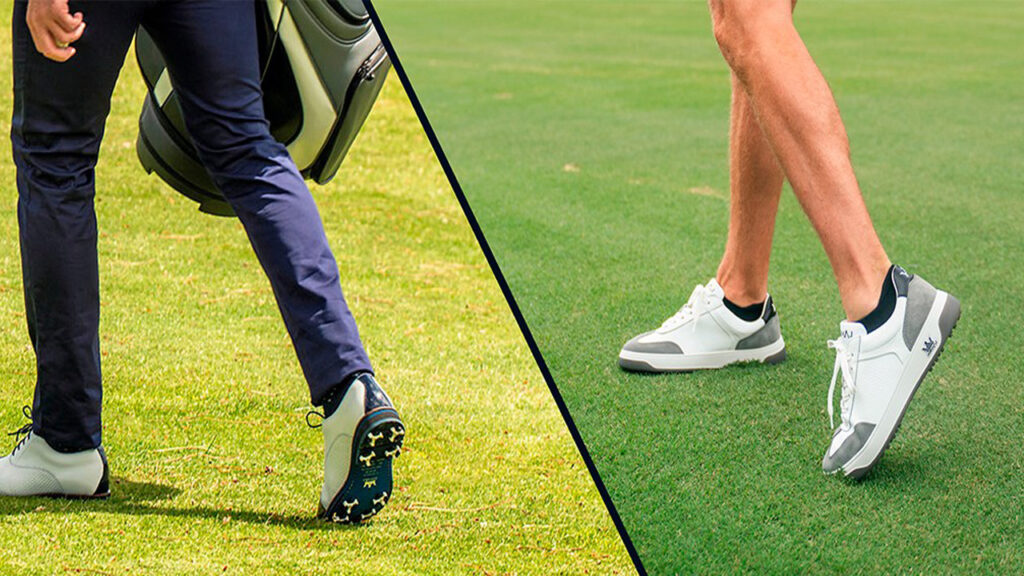When you step onto the golf course, every swing, every step, hinges on the traction and stability of your footwear. Just as the tires of a car grip the road, the soles of your golf shoes provide the crucial connection between you and the turf. Slippery footing can spell disaster for your game, leading to errant shots and missed opportunities, even on an indoor golf simulator. In recent years, golfers have been scrutinizing the age-old debate of spikes vs spikeless golf shoes, weighing the benefits and drawbacks of each option. With the dramatic evolution of spikeless shoes, many players are finding them to be a serious contender for their next footwear choice. Here’s a closer look at what to consider when deciding between spikes and spikeless golf shoes.
Traction: The Foundation of Your Game
When it comes to traction on the golf course, the stakes couldn’t be higher. Just as a car needs reliable tires to grip the road, golfers rely on their shoes to provide the traction needed for a solid stance and powerful swing. Slippery footing can throw off your balance, compromise your swing mechanics, and ultimately result in poor shot outcomes.
In the pursuit of optimal traction, many golfers turn to spiked shoes, which feature cleats or spikes embedded in the sole to bite into the turf and provide stability. These traditional spiked shoes offer unparalleled grip on a variety of surfaces, ensuring maximum traction even in wet or muddy conditions. However, some golfers find the metal spikes to be uncomfortable or damaging to the greens, prompting them to explore alternative options.
The Rise of Spikeless Shoes: Evolving Technology and Performance
In recent years, spikeless golf shoes have undergone a remarkable evolution, emerging as a viable alternative to traditional spiked footwear. These spikeless shoes feature molded rubber or specialized tread patterns on the sole, offering traction and stability without the need for protruding cleats.
One of the key advantages of spikeless shoes is their versatility. Unlike traditional spiked shoes, which are designed primarily for use on the golf course, spikeless shoes can easily transition from the fairways to the clubhouse or even the streets. This versatility makes spikeless shoes a practical choice for golfers who value convenience and style without sacrificing performance.
Comfort and Convenience: The Appeal of Spikeless Shoes
Beyond their performance on the course, spikeless golf shoes offer a range of benefits in terms of comfort and convenience. The absence of metal spikes eliminates the need for frequent replacement and maintenance, reducing the long-term cost of ownership. Additionally, spikeless shoes tend to be lighter and more flexible than their spiked counterparts, providing a more natural and comfortable walking experience during a round of golf.
Moreover, spikeless shoes are often more forgiving on the greens, as they minimize the risk of damage caused by metal spikes. This consideration is especially important for golfers who frequent courses with strict maintenance standards or delicate putting surfaces.
The Verdict: Finding the Right Fit for Your Game
In the end, the choice between spikes and spikeless golf shoes ultimately comes down to personal preference and playing style. For golfers who prioritize maximum traction and stability, traditional spiked shoes may be the preferred option. However, for those seeking versatility, comfort, and convenience, spikeless shoes offer a compelling alternative that delivers performance without compromise.
When selecting your next pair of golf shoes, take the time to consider your individual needs and preferences. Try on different styles, walk a few rounds, and pay attention to how each option feels on the course. Whether you opt for the tried-and-true grip of spiked shoes or the modern versatility of spikeless footwear, investing in the right pair of golf shoes can make all the difference in your sports.

